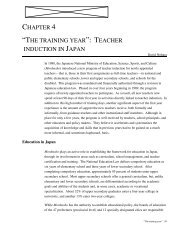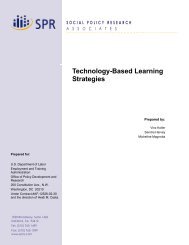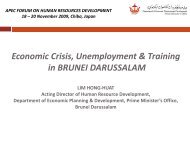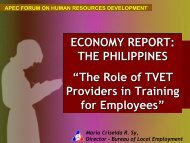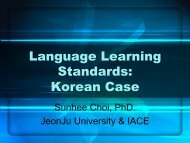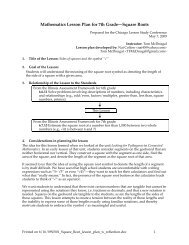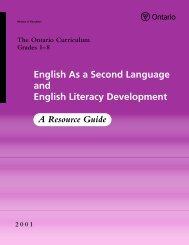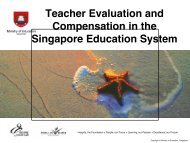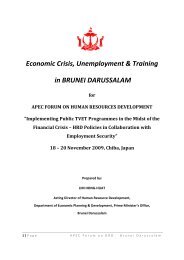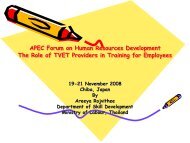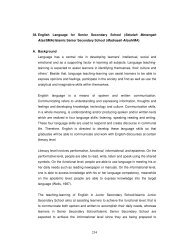Quality Assurance Systems in Asia-Pacific Economic Cooperation
Quality Assurance Systems in Asia-Pacific Economic Cooperation
Quality Assurance Systems in Asia-Pacific Economic Cooperation
You also want an ePaper? Increase the reach of your titles
YUMPU automatically turns print PDFs into web optimized ePapers that Google loves.
ENHANCEMENT OF QUALITY ASSURANCE SYSTEMS IN HIGHER EDUCATION IN APEC MEMBER ECONOMIES<br />
HKCAA took steps to reform its operat<strong>in</strong>g and f<strong>in</strong>anc<strong>in</strong>g models, as well as its accreditation<br />
approach and procedures.<br />
To review the arrangements for the provision of higher education <strong>in</strong> Hong Kong and the<br />
direction UGC has to take <strong>in</strong> advis<strong>in</strong>g the <strong>in</strong>stitutions, UGC conducted a review <strong>in</strong> 2001. The<br />
Review was led by a senior member of the UGC and was assisted by a Steer<strong>in</strong>g Committee,<br />
composed ma<strong>in</strong>ly of local UGC members who were directly <strong>in</strong>volved <strong>in</strong>, or were familiar with,<br />
higher education <strong>in</strong> Hong Kong.<br />
Some QA systems have undergone external reviews to ensure their own quality. NZUAAU<br />
has undergone reviews <strong>in</strong> 1997 and 2001 and had a detailed discussion with each of the<br />
universities <strong>in</strong> 2002. CNAP and AUQA have undergone external reviews <strong>in</strong> 2006. CNAP<br />
requested a detailed external review by INQAAHE and <strong>in</strong> preparation for that it carried out a<br />
self assessment exercise. An <strong>in</strong>ternational team appo<strong>in</strong>ted by the Board of INQAAHE visited<br />
the agency, <strong>in</strong>terviewed a selection of stakeholders and wrote a report.<br />
While CNAP opted to be reviewed aga<strong>in</strong>st the Guidel<strong>in</strong>es for Good Practice (GGP) for <strong>Quality</strong><br />
<strong>Assurance</strong> Agencies developed by INQAAHE, AUQA chose both its own objectives and the<br />
GGP of INQAAHE for its review.<br />
In the US, the US regional accreditors owned by HEIs demonstrate their quality by seek<strong>in</strong>g<br />
recognition either by the Council on Higher Education Accreditation (CHEA) or by the US<br />
Department of Education. Although seek<strong>in</strong>g recognition by these bodies is voluntary, federal<br />
funds such as student aid is are allocated only to <strong>in</strong>stitutions that are accredited by the US<br />
Department of Education. Accredit<strong>in</strong>g bodies that seek recognition by the CHEA must<br />
demonstrate that they meet the CHEA recognition standards. Accredit<strong>in</strong>g organisations are<br />
expected to advance academic quality, demonstrate accountability, encourage improvement,<br />
employ appropriate procedures, cont<strong>in</strong>ually reassess accreditation practices and possess<br />
sufficient resources. The recognition review has an evaluation procedure similar to the<br />
accreditation exercise of the HEIs with self-study and external review. In that process (of<br />
every six years), there are even sessions that are open to the public.<br />
In Australia, AUQA is responsible for conduct<strong>in</strong>g quality audits of State and Territory<br />
Government higher education accreditation authorities on a five-yearly cycle. Action taken <strong>in</strong><br />
response to audit reports is the responsibility of the relevant Department and M<strong>in</strong>ister. Audit<br />
by the AUQA serves as an accountability check for the State and Territory Government higher<br />
education accreditation authorities.<br />
In Mexico, COPAES has a similar function. Established as a civic association, it has been<br />
recognised by the Public Education M<strong>in</strong>istry of Mexico to confer official recognition to qualified<br />
program accreditation agencies <strong>in</strong> México. Agencies recognised by COPAES grant program<br />
accreditation at specific subject areas and/or discipl<strong>in</strong>es, at undergraduate and graduate<br />
level. COPAES has conferred recognition to ten program accredit<strong>in</strong>g agencies. It uses the<br />
general framework of self evaluation and external review with on-site visit. It has developed<br />
statistical data/performance <strong>in</strong>dicators to guide its assessment. It also considers <strong>in</strong>puts from<br />
student surveys. The specific areas considered by COPAES for its assessment are given <strong>in</strong><br />
Appendix 2. COPAES publishes the names of those that merited recognition and the names<br />
of the programs accredited by them, <strong>in</strong> newspapers and Internet, mention<strong>in</strong>g the valid period<br />
for this recognition<br />
There is a grow<strong>in</strong>g awareness among the QA agencies and their networks about the benefits<br />
of meta-evaluation or ‘evaluat<strong>in</strong>g the evaluation itself’ as a critical measure to ensure quality<br />
of quality assurance.<br />
8.2 Effective <strong>Quality</strong> Practices<br />
QA bodies judge the effectiveness of their quality practices <strong>in</strong> different ways and depend<strong>in</strong>g<br />
on their perception, what they consider as ‘effective quality practices’ varies. Some QA<br />
systems consider the salient features of the QA framework as effective quality practices;<br />
some pay attention to the success towards <strong>in</strong>tended change <strong>in</strong> the higher education sector;<br />
some look at the immediate impact and a few others see the long term benefits. The follow<strong>in</strong>g<br />
30



